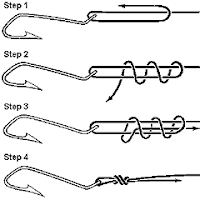


In nylon and fluorocarbon monofilament lines, this friction hot spot can literally melt the outer skin of the line, causing immediate knot failure or – perhaps even more gut-wrenchingly – a serious weak spot that will let go later in the fight, most likely as you strain to bring that catch of a lifetime within range of the bank or landing net. The second, equally insidious, form of slip failure occurs when one or more turns of a knot slip just enough under load to momentarily create an intense friction point. It makes you feel sick to your stomach… and it should! You’ve seen that accusatory little bedspring at the end of your own line, haven’t you? We all have. The telltale sign of total slip failure is a little curly “pig’s tail” or corkscrew at the end of the line where the hook, swivel, or lure was supposed to be. At its most extreme, the knot simply slips completely undone, with the tag end or tail sliding all the way back through the various turns and twists under pressure until the connection lets go. Knot slippage takes two catastrophic forms. Second, they’re poorly constructed in the first place, resulting in one strand of line effectively cutting across and through another. Sadly, knot failure is and will most likely remain the single greatest cause of lost fish. Those knots may need to be tied as quickly as possible, in poor light, on a pitching boat, or in the wind, rain, or cold, often with hands still trembling uncontrollably after our latest adrenalin-charged fishy encounter. Every one of these connections needs to be as strong as we can make it, maintaining the maximum integrity of our tackle and, we hope, avoiding the addition of another “one that got away” story to the endless list. So most of us still need to tie knots in our day-to-day fishing… Sometimes lots of knots!ĭuring an intensive fishing session, an angler might tie a dozen or more knots in just a few hours. Many are a tad bulky, and there’s also that nagging doubt in the back of the user’s mind about their strength and reliability under practical fishing conditions. These things work, to varying degrees, but have never taken off.
#Fishing knotes series
However, it’s still impossible to buy a packet of strong knots! Clever folks have done their best to come up with nifty devices intended to eliminate the need for knots by allowing the attachment of a clip or snap directly to the end of a line or leader via a series of wraps and twists. Modern hooks are lighter, finer, stronger, and – most importantly – sharper straight from the pack than ever before. These days, there’s no excuse for not using a sharp hook every time we cast a line. Everything else is secondary… Everything! The two most important keys to consistent fishing success are a sharp hook and being able to tie the correct fishing knots.


 0 kommentar(er)
0 kommentar(er)
